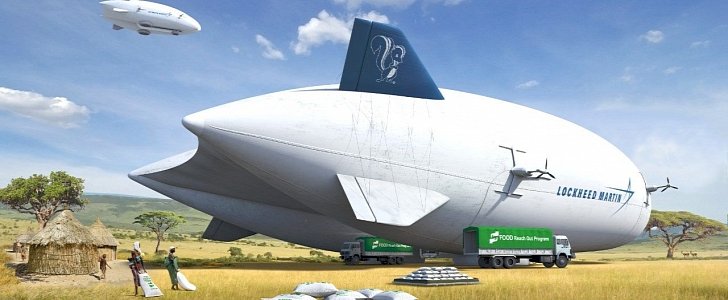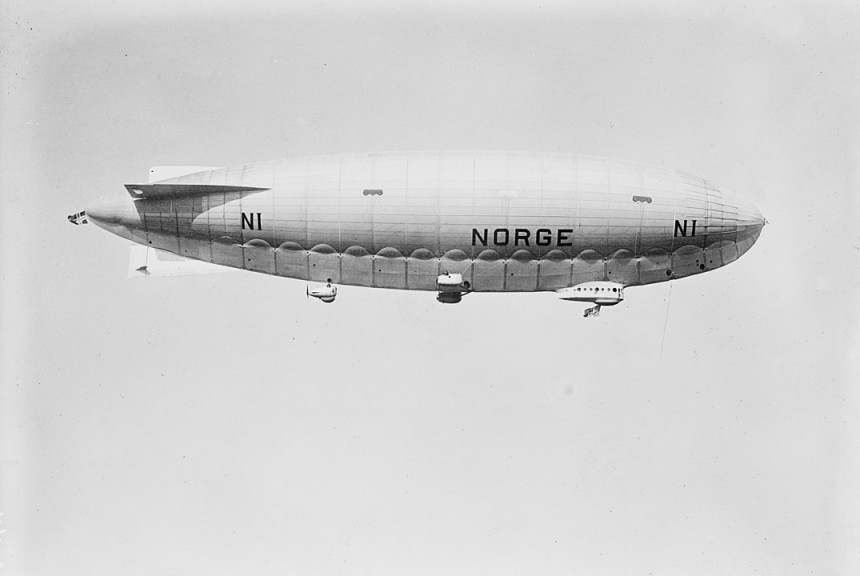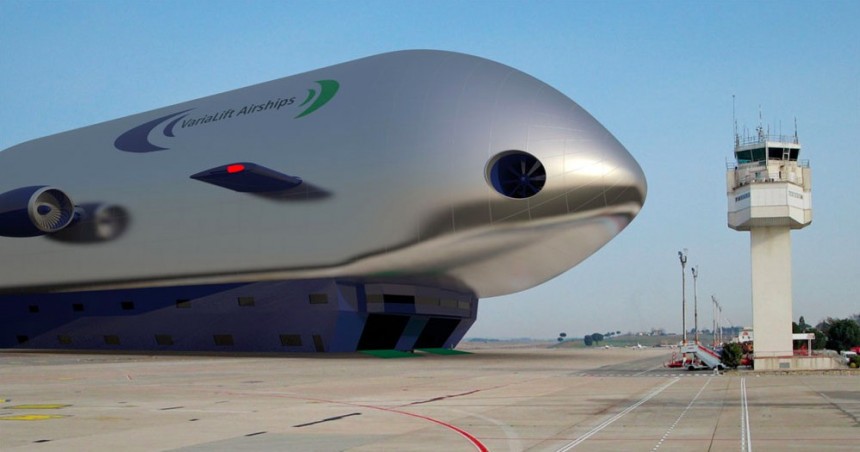Airships, sometimes called dirigibles, dirigible balloons or blimps, are lighter-than-air aircraft whose popularity peak was reached in the interwar period.
Back then they were used for passenger and cargo carrying duties, but after the Second World War, they fell out of favor because of the development of the airlines we know today. Airships were only really used for advertising purposes, for weather research, various types of surveillance and for sightseeing after the war.
In the 1920s and 1930s, flying aboard an airship was seen as the height of luxury. And they could even cross the Atlantic, ferrying passengers and mail over the ocean in a matter of days, far quicker than equivalent journey on water.
The Hindenburg was, in 1936, one of the biggest and most luxurious airships in the world. It did the transatlantic trip in around four days with 72 passengers on board, as well as quite a big crew of between 40 and 60 people.
Only wealthy people chose to travel by airship, though, as a one-way trip from Frankfurt to New Jersey cost the equivalent of about $7,000 in today’s money.
Space was at a premium too on board the Hindenburg (or any airship for that matter) - while the common areas, such as the lounge, were fairly open and inviting, the rooms where people stayed and slept were cramped and had actual bunk beds; they really didn’t feel as luxurious as the ticket price may have suggested.
The Hindenburg is most famous for how it burst into flames in May, 1937, with 36 passengers and 61 crew members on board. It was engulfed by fire extremely quickly primarily because what kept it aloft was that it was full of hydrogen, but miraculously, 23 of the passengers and 39 crew survived the horrific fire.
After the Hindenburg disaster, airships fell out of favor and regular long-haul passenger flights were ceased. Over the following decades, some airships were still made, with various purposes in mind (most of them military), but in recent years there have been some new and innovative airships made for civilian duties.
They look quite different to the traditional airship shape, because technology has since advanced and designs can now be tailored more for their desired purpose. Take these designs by U.K.-based Varialift Airships, a company that promises its offerings are reliable, economical to run and are able to carry significant loads.
The airships it’s proposing have a lightweight aluminum structure, at least a 40-year work life span, reduced acquisition costs compared to conventional cargo airplanes and a promised reduction of fuel usage by 80 to 90 percent. On top of these, you also have the traditional airship advantage that it can take off and land vertically and it doesn’t really need specialized infrastructure in order to operate.
Lockheed Martin is also proposing an airship, this time closer to the more traditional image of an airship. Unlike the Varialift idea, this one, which the company calls the Hybrid Airship, can carry 21 tons of cargo and up to 19 passengers much more efficiently than a conventional plane.
The American aerospace company has apparently been working on the Hybrid Airship for the last two decades and it even has some genuinely cool innovations that are worth talking about. It is called a hybrid airship because it partly relies on the lighter-than-air gas it’s filled with for lift and partly on aerodynamic lift just like traditional planes.
Lockheed Martin has also devised what it calls the Spider, a robot designed to move around the airship’s surface to look for holes which it proceeds to fix.
Manual inspection of the canvas is a tedious and time consuming task when done by people, and the craft needs to be deflated in order for the check to be performed. The Spider, on the other hand, moves around the inflated airship saving even more time, especially since it does its thing autonomously, a bit like those robotic vacuum cleaners that clean your house without requiring human intervention.
Another modern hybrid airship, this time one that’s actually already built (unlike the aforementioned two ships which are still just concepts). It’s called the Airlander 10, built by Hybrid Air Vehicles Limited in the U.K., and it was originally intended to be used by the U.S. Army as an unmanned means of carrying cargo.
But the deal with the U.S. Army fell through and the Airlander 10 was converted to be operated by an actual pilot and it was mostly used as a demonstrator vehicle to prove that hybrid airships are viable. It apparently crashed last year, and the decision was taken not to rebuild it. The company behind it intends to build a prototype of its actual production model which it says will be ready sometime in the early 2020s.
This particular example was then just used for testing purposes, but we’re sure that if this type of airship gains popularity, they will be used to carry passengers for other more leisure-oriented purposes.
In the 1920s and 1930s, flying aboard an airship was seen as the height of luxury. And they could even cross the Atlantic, ferrying passengers and mail over the ocean in a matter of days, far quicker than equivalent journey on water.
The Hindenburg was, in 1936, one of the biggest and most luxurious airships in the world. It did the transatlantic trip in around four days with 72 passengers on board, as well as quite a big crew of between 40 and 60 people.
Only wealthy people chose to travel by airship, though, as a one-way trip from Frankfurt to New Jersey cost the equivalent of about $7,000 in today’s money.
The Hindenburg is most famous for how it burst into flames in May, 1937, with 36 passengers and 61 crew members on board. It was engulfed by fire extremely quickly primarily because what kept it aloft was that it was full of hydrogen, but miraculously, 23 of the passengers and 39 crew survived the horrific fire.
After the Hindenburg disaster, airships fell out of favor and regular long-haul passenger flights were ceased. Over the following decades, some airships were still made, with various purposes in mind (most of them military), but in recent years there have been some new and innovative airships made for civilian duties.
They look quite different to the traditional airship shape, because technology has since advanced and designs can now be tailored more for their desired purpose. Take these designs by U.K.-based Varialift Airships, a company that promises its offerings are reliable, economical to run and are able to carry significant loads.
Lockheed Martin is also proposing an airship, this time closer to the more traditional image of an airship. Unlike the Varialift idea, this one, which the company calls the Hybrid Airship, can carry 21 tons of cargo and up to 19 passengers much more efficiently than a conventional plane.
The American aerospace company has apparently been working on the Hybrid Airship for the last two decades and it even has some genuinely cool innovations that are worth talking about. It is called a hybrid airship because it partly relies on the lighter-than-air gas it’s filled with for lift and partly on aerodynamic lift just like traditional planes.
Lockheed Martin has also devised what it calls the Spider, a robot designed to move around the airship’s surface to look for holes which it proceeds to fix.
Manual inspection of the canvas is a tedious and time consuming task when done by people, and the craft needs to be deflated in order for the check to be performed. The Spider, on the other hand, moves around the inflated airship saving even more time, especially since it does its thing autonomously, a bit like those robotic vacuum cleaners that clean your house without requiring human intervention.
Another modern hybrid airship, this time one that’s actually already built (unlike the aforementioned two ships which are still just concepts). It’s called the Airlander 10, built by Hybrid Air Vehicles Limited in the U.K., and it was originally intended to be used by the U.S. Army as an unmanned means of carrying cargo.
But the deal with the U.S. Army fell through and the Airlander 10 was converted to be operated by an actual pilot and it was mostly used as a demonstrator vehicle to prove that hybrid airships are viable. It apparently crashed last year, and the decision was taken not to rebuild it. The company behind it intends to build a prototype of its actual production model which it says will be ready sometime in the early 2020s.
This particular example was then just used for testing purposes, but we’re sure that if this type of airship gains popularity, they will be used to carry passengers for other more leisure-oriented purposes.











